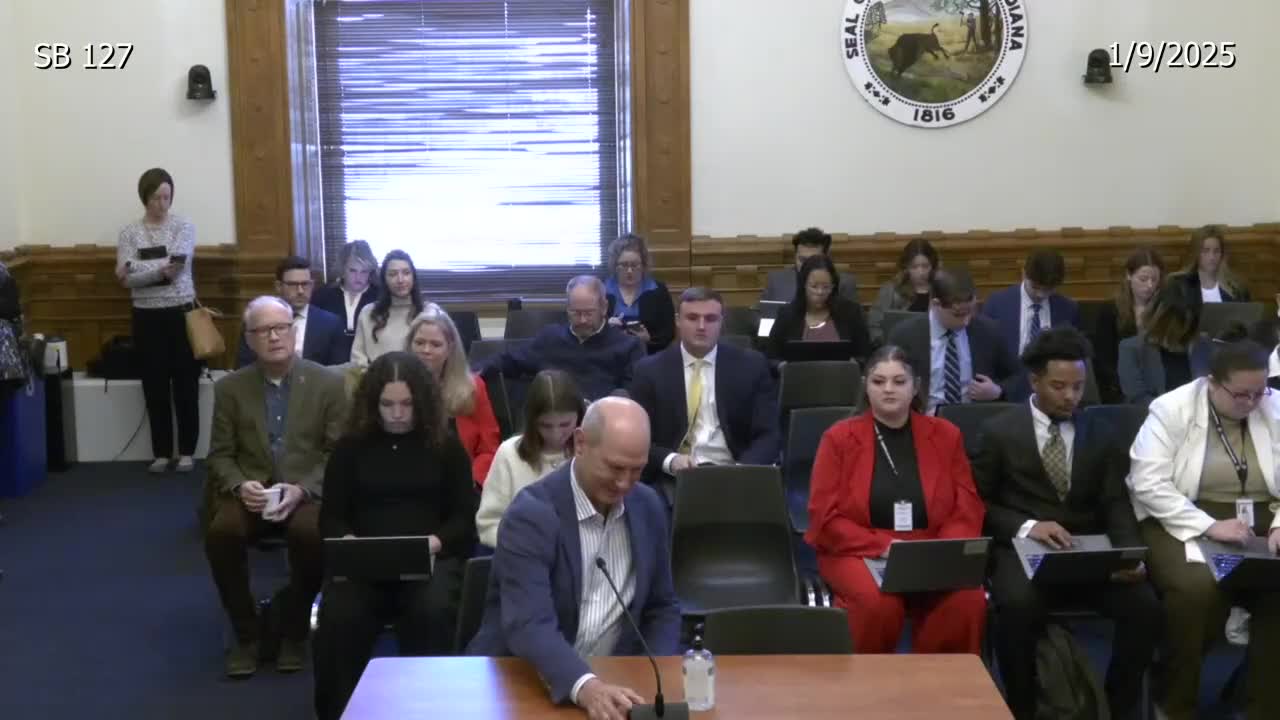Committee clears bill to standardize permitting for battery‑charged perimeter alarm systems
January 09, 2025 | 2025 Legislature IN, Indiana
This article was created by AI summarizing key points discussed. AI makes mistakes, so for full details and context, please refer to the video of the full meeting. Please report any errors so we can fix them. Report an error »

A Senate committee gave Senate Bill 127 a favorable recommendation after hearing testimony that the measure would standardize permitting for battery‑charged perimeter alarm systems used behind existing fences and walls.
The bill would create a consistent administrative classification and permitting protocol for alarm‑style perimeter systems that use battery power and solar charging, proponents told the committee. That classification, supporters said, would prevent municipalities from treating the devices inconsistently as alarms, fences or other structures.
Michael Pate, director of government relations for Amarok, told the committee the company has helped pass similar legislation in 26 states. "We really don't have any continuity of permitting across the state," Pate said. He described installations that had been approved by one municipal office and later ordered removed by another, and he said the bill would let businesses "protect themselves with their own money."
Pate described the systems as installed inside an already approved barrier, set back a few inches, powered by a 12‑volt battery kept charged with solar panels and not connected to building electrical service. He said the energizer charges to about 7,000 volts at a very low current and that the device sends a brief pulse every 1.1 seconds to check continuity. "It releases that energy down that interior line back to the alarm panel every 1.1 seconds," Pate said. He said the pulse lasts about 0.0003 seconds and that the systems are a trigger mechanism returning to an alarm panel; if the panel detects five consecutive failed returns it initiates a call sequence to the property’s contact list.
Committee members questioned whether the devices could cause harm and asked for clarification on how they differ from agricultural or high‑voltage electric fences. A senator summarized the safety explanation: the systems are designed with very short pulses and low current so that a person who contacts the line would typically feel a brief jolt comparable to a static shock rather than sustain an injury.
After testimony and questions, the committee moved, seconded and called the roll. The committee recorded the following affirmative roll‑call responses: Senator Shelley Yoder (aye), Senator Taylor (aye), Senator Rick Niemeyer (aye), Senator Bohotschek (aye), Senator Becker (aye), Senator Darnell (aye), Senator Daryl Schmidt (aye), Senator Jim Toms (aye), Senator Jackson (aye), and Senator Jim Buck (aye). The committee announced the bill was given a "due pass" recommendation.
The committee record did not include a separate formal amendment or statutory citations during the hearing. No public commenters besides the Amarok representative testified on SB 127 at this hearing.
The committee discussion was recorded as discussion only of device characteristics, safety, and permitting consistency; the committee's formal action was to recommend the bill (due pass).
The bill would create a consistent administrative classification and permitting protocol for alarm‑style perimeter systems that use battery power and solar charging, proponents told the committee. That classification, supporters said, would prevent municipalities from treating the devices inconsistently as alarms, fences or other structures.
Michael Pate, director of government relations for Amarok, told the committee the company has helped pass similar legislation in 26 states. "We really don't have any continuity of permitting across the state," Pate said. He described installations that had been approved by one municipal office and later ordered removed by another, and he said the bill would let businesses "protect themselves with their own money."
Pate described the systems as installed inside an already approved barrier, set back a few inches, powered by a 12‑volt battery kept charged with solar panels and not connected to building electrical service. He said the energizer charges to about 7,000 volts at a very low current and that the device sends a brief pulse every 1.1 seconds to check continuity. "It releases that energy down that interior line back to the alarm panel every 1.1 seconds," Pate said. He said the pulse lasts about 0.0003 seconds and that the systems are a trigger mechanism returning to an alarm panel; if the panel detects five consecutive failed returns it initiates a call sequence to the property’s contact list.
Committee members questioned whether the devices could cause harm and asked for clarification on how they differ from agricultural or high‑voltage electric fences. A senator summarized the safety explanation: the systems are designed with very short pulses and low current so that a person who contacts the line would typically feel a brief jolt comparable to a static shock rather than sustain an injury.
After testimony and questions, the committee moved, seconded and called the roll. The committee recorded the following affirmative roll‑call responses: Senator Shelley Yoder (aye), Senator Taylor (aye), Senator Rick Niemeyer (aye), Senator Bohotschek (aye), Senator Becker (aye), Senator Darnell (aye), Senator Daryl Schmidt (aye), Senator Jim Toms (aye), Senator Jackson (aye), and Senator Jim Buck (aye). The committee announced the bill was given a "due pass" recommendation.
The committee record did not include a separate formal amendment or statutory citations during the hearing. No public commenters besides the Amarok representative testified on SB 127 at this hearing.
The committee discussion was recorded as discussion only of device characteristics, safety, and permitting consistency; the committee's formal action was to recommend the bill (due pass).
View full meeting
This article is based on a recent meeting—watch the full video and explore the complete transcript for deeper insights into the discussion.
View full meeting
